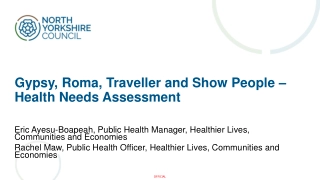Understanding Quantitative Research Designs in Health Research
Quantitative research designs play a crucial role in health research, offering various methodologies like experimental and observational designs. Observational designs are commonly used and can establish associations but not causality. Longitudinal designs track outcomes over time, providing valuable insights. However, they come with limitations such as time-consuming nature, subject loss, and potential biases. Despite challenges, longitudinal designs offer real-time data collection and clearer time-order relationships, making them beneficial for studying rare risk factors.
- Quantitative research
- Health research
- Observational designs
- Longitudinal studies
- Research methodologies
Understanding Quantitative Research Designs in Health Research
PowerPoint presentation about 'Understanding Quantitative Research Designs in Health Research'. This presentation describes the topic on Quantitative research designs play a crucial role in health research, offering various methodologies like experimental and observational designs. Observational designs are commonly used and can establish associations but not causality. Longitudinal designs track outcomes over time, providing valuable insights. However, they come with limitations such as time-consuming nature, subject loss, and potential biases. Despite challenges, longitudinal designs offer real-time data collection and clearer time-order relationships, making them beneficial for studying rare risk factors.. Download this presentation absolutely free.
Presentation Transcript
DAY 3: QUANTITATIVE DESIGNS Sioape Kupu Health Research Officer
QUANTITATIVE STUDIES Exploratory designs Descriptive studies, case studies, etc Explanatory designs 1) Experimental designs 2) Observational designs Cross-Sectional Longitudinal Case-control
OBSERVATIONAL DESIGNS Observational Designs We can't always use experimental designs Experiments won't always give you the right answer Other designs are commonly used in health services research We often have to, or are better off, using observational designs Can only establish ASSOCIATIONS!
OBSERVATIONAL DESIGNS Longitudinal /cohort (follow-up) design Measure the development of the outcome of interest over time. Longitudinal comparison design Measure the differences between groups over time. Cross-sectional design Measure the differences between groups at a point in time Case-control design Compares exposure to risk factors between those with and without a condition
LONGITUDINAL / COHORT DESIGN Longitudinal (follow-up) design Measure the development of the outcome of interest over time. Outcomes (DV) Outcomes (DV) Study Sample Measure (DV) Measure (DV) Future Present
LONGITUDINAL DESIGN Longitudinal comparison design Measure the differences between groups over time. Group A (IV 1) Intervention Group Outcomes 2 (DV2) Outcomes 1 (DV1) Study Sample Group B (IV 2) Comparison Group Measure (DV) Measure (DV) Natural Group/ Levels (IV) Future Present
LONGITUDINAL DESIGN Advantages Real-time data collection (not done retrospectively) Time-order relationships clearer Good for Rare risk factors
LONGITUDINAL DESIGN Disadvantages Limited causal interpretation Time consuming and costly Population selection is often problematic Subject loss Changes in subject characteristics Surveillance bias Not good for Rare diseases (outcomes)
CROSS-SECTIONAL DESIGN Cross-sectional design (Prevalence) Measure the differences between groups at a point in time Group A (IV 1) Outcomes (DV) Study Sample Group B (IV 2) Measure (DV) Natural Group/ Levels (IV) Present
CROSS-SECTIONAL DESIGN Advantages Easy to do Immediate data Limited problem with drop-outs
CROSS-SECTIONAL DESIGN Disadvantages No causal interpretation (no time-order relationship) Selection bias (study may only include a special group) Response bias
CASE-CONTROL DESIGN A design used to assess the relationship between the exposure to a risk factor and the development of a condition. It compares the exposure distributions between the groups of people with and without a condition. It typically uses only a fraction of the subjects in the control group
CASE-CONTROL DESIGN Case-control design Compares exposure to risk factors between those with and without a condition. Cases (Have Outcome) Risk Factor (+) Risk Factor (-) Control (Don t have outcome) Natural Group/ Levels (IV) Measure (DV)
CASE-CONTROL DESIGN Advantages: Less constrained by the natural frequency of the disease Shorter and cheaper than longitudinal studies Can be used when an experimental design is not logistically or ethically feasible Good for Rare diseases (outcomes)
CASE-CONTROL DESIGN Disadvantages: Less well defined target population Concerns of various types of selection biases Limited causal interpretation. No absolute measure for the effect of the independent variable Recall Bias Not good for Rare exposures (risk factors)
ACTIVITY What is the aim or objective of this research? What relationship is the article trying to find out? (exposure outcome) Identify the exposure or Independent Variable Identify the outcome or Dependent Variable Who are the population of interest? What methodology is being used? What do the findings say in your own interpretation?
(Beasley et al., 1981). Abstract 2: A study of 22 707 Chinese men in Taiwan was set up to investigate the association between the hepatitis B surface antigen (HBsAg) and the development of primary hepatocellular carcinoma. The study was conducted among male government employees who were enrolled through routine health care services. All participants completed a health questionnaire and provided a blood sample at the time of their entry into the study. Participants were then followed up for an average of 3.3 years
Abstract 3: The study attempts to identify the relationship between use of conjugated estrogens and the risk of endometrial cancer was examined among 188 white women aged 40 80 years with newly diagnosed endometrial cancer and 428 controls of similar age hospitalized for non-malignant conditions requiring surgery at the Boston Hospital for Women Parkway Division, Massachusetts, between January 1970 and June 1975. The data on drug use and reproductive variables were extracted from hospital charts and from the medical records of each woman s private physician. Thirty-nine per cent of the cases and 20% of the controls had used conjugated estrogens in the past.
ABSTRACT 3 Information about children s perception of their health-related quality of life (HRQoL) and its socio-demographic distribution is, however, limited and almost exclusively reliant on data from Western higher income countries. The study aims to investigate HRQoL in schoolchildren in Tonga, a lower income South Pacific Island country, and to compare this to HRQoL of children in other countries, including Tongan children living in New Zealand, a high-income country in the same region. The study from Tonga addresses all secondary schoolchildren (11 18 years old) on the outer island of Vava u and in three districts of the main island of Tongatapu (2,164 participants). A comparison group drawn from the literature comprised children in 18 higher income and one lower income country (Fiji). A specific New Zealand comparison group involved all children of Tongan descendent at six South Auckland secondary schools (830 participants). HRQoL was assessed by the self-report Pediatric Quality of Life Inventory 4.0. Results of the study show HRQoL in Tonga was overall similar in girls and boys, but somewhat lower in children below 15 years of age. The children in Tonga experienced lower HRQoL than the children in all of the 19 comparison countries, with a large difference between children in Tonga and the higher income countries and a small difference between Tonga and the lower income country Fiji. The children in Tonga also experienced lower HRQoL than Tongan children living in New Zealand. The results reveal worrisome low HRQoL in children in Tonga and point towards a potential general pattern of low HRQoL in children living in lower income countries, or, alternatively, in the South Pacific Island countries
(Muoz et al., 1992a). Abstract 4: A population-based study was carried out in Spain and Colombia to assess the relationship between cervical cancer and exposure to human papillomavirus (HPV), selected aspects of sexual and reproductive behaviour, use of oral contraceptives, screening practices, smoking, and possible interactions between them. The study included 436 incident cases of histologically confirmed invasive squamous-cell carcinoma of the cervix and 387 controls of similar age randomly selected from the general population that generated the cases.
(Bobak, Skodova & Marmot (2003). Beer and obesity) Abstract 5: There is a common notion that beer drinkers are, on average, more 'obese' than either nondrinkers or drinkers of wine or spirits. This is reflected, for example, by the expression 'beer belly'. However, the few studies on the association between consumption of beer and abdominal obesity produced inconsistent results. We examined the relation between beer intake and waist-hip ratio (WHR) and body mass index (BMI) in a beer-drinking general population of six districts of the Czech Republic. A random sample of 1141 men and 1212 women aged 25-64 y (response rate 76%) completed a questionnaire and underwent a short examination in a clinic. Intake of beer, wine and spirits during a typical week, frequency of drinking, and a number of other factors were measured by a questionnaire. Beer intake was not related to BMI in men. In women, beer intake was not related to WHR, but there was a weak inverse association with BMI. It is unlikely that beer intake is associated with a largely increased WHR or BMI.
(Pacific Islands Families Study, Faculty of Health and Environmental Sciences, AUT University, Auckland, New Zealand.). Abstract 6: The Pacific Islands Families (PIF) study is a longitudinal investigation of a cohort (N=1376) of Pacific infants born in New Zealand (NZ), and their mothers and fathers. The PIF study aimed to determine: (1) the prevalence of disciplinary and nurturing parenting practices used with children at 12 months of age, and (2) the demographic, maternal and lifestyle factors associated with parenting practices. At the 12-month measurement point, mothers (N=1207) were interviewed about their parenting practices using a modified version of the Parent Behavior Checklist.. At the unilabiate level, high discipline scores were significantly associated with gambling, postnatal depression and lack of alignment to either Pacific or to European traditions. However the strongest association with discipline was the ethnicity variable with Tongan mothers reporting significantly higher disciplinary behaviors that all other ethnicities.
DAY 3 OBJECTIVES Understand the concepts of all Observational Studies Cross-Sectional (Prevalence) Cohort (Longitudinal) Case-Control Study
READING Bouma, G., D. and R. Ling (2004). Chapter 6: Selecting a research design. The research process. Melbourne ; New York, Oxford University Press: 86-111. MALO

















































